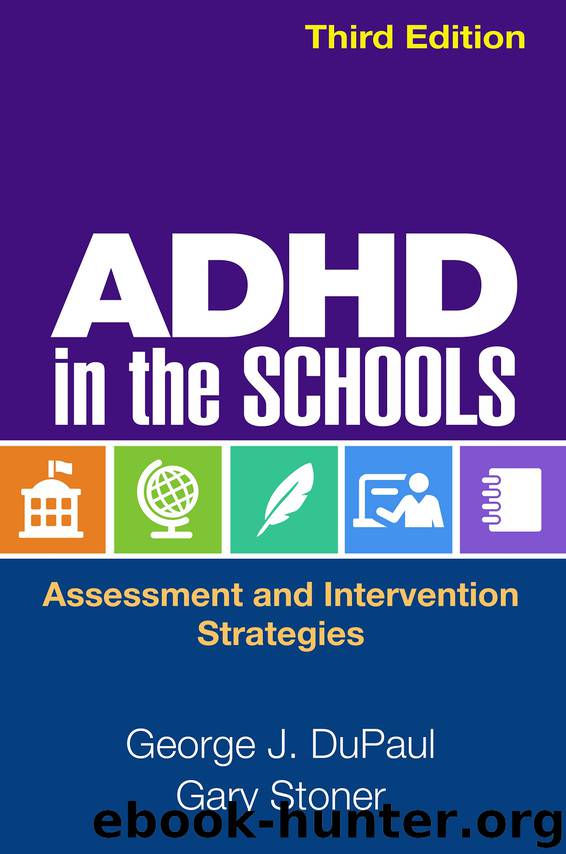ADHD in the Schools, Third Edition by George J. DuPaul & Gary Stoner

Author:George J. DuPaul & Gary Stoner [George J. DuPaul, Gary Stoner]
Language: eng
Format: epub
Publisher: The Guilford Press
TASK AND INSTRUCTIONAL MODIFICATIONS
Task Modifications
An educational accommodation that can improve the academic performance of students diagnosed with ADHD is TM. TM involves revising the curriculum or aspects of it in an attempt to reduce problem behaviors and increase appropriate classroom behaviors. In addition, TM is a proactive strategy, as changes are made before the curriculum is presented to the student. It has been argued that this type of positive academic modification is more responsive to the individual needs of the student (Meyer & Evans, 1989).
One type of TM, choice making, requires the student to choose activities from among two or more concurrently presented options. Previous studies examining the effects of choice making on students with developmental disabilities have demonstrated increases in social behavior and decreases in levels of disruptive behavior (Dyer, Dunlap, & Winterling, 1990; Koegel, Dyer, & Bell, 1987). The effects of classroom-based choice making were examined in a study conducted by Dunlap and colleagues (1994). In this study, the effects of choice making on the task engagement and disruptive behaviors of three students with emotional and behavioral disorders were examined. Of these three participants, one 12-year-old male was identified as having ADHD. This student was provided with a menu of academic tasks in English and spelling from which to choose. The results of the study indicated that choice making led to reliable and consistent increases in task engagement with concomitant reductions in disruptive behavior. Therefore, choice making may be a valuable TM for students with ADHD. Not only does allowing students to chose their assignments reduce disruptive behaviors and improve task engagement but this strategy promotes student initiative and independence. However, it is not clear whether this type of TM is effective at improving academic performance.
Based on the premise that children with ADHD have a greater need for cognitive stimulation than their nondiagnosed peers, a few TM studies have investigated the effects of modifying intratask stimulation (Zentall, 1989; Zentall & Leib, 1985). In one study conducted in a classroom setting, Zentall and Leib (1985) investigated the effects of added structure on the activity levels and performance of children using a repeated-measures design. Eight participants identified as hyperactive were randomly assigned to one of two experimental art conditions in which the structure of the task requirement was manipulated (explicit instructions combined with task materials vs. nonspecific instructions without task materials). Results indicated significant decreases in activity level of the participants, and suggested that modifying task requirements may affect activity levels of children identified as hyperactive.
In another classroom-based study, Zentall (1989) examined whether adding color to relevant cues in a spelling task improved the performance of children diagnosed as hyperactive. Participants included 20 hyperactive and 26 comparison boys who were preassessed on spelling achievement and randomly assigned to one of two condition-order groups. Results of this study indicated the participants identified as hyperactive demonstrated better performance than the comparison participants when relevant color was added to spelling tasks. Interestingly, the addition of color to irrelevant aspects of the task resulted in decreases in spelling performance.
Download
This site does not store any files on its server. We only index and link to content provided by other sites. Please contact the content providers to delete copyright contents if any and email us, we'll remove relevant links or contents immediately.
The Art of Coaching Workbook by Elena Aguilar(51078)
Trainspotting by Irvine Welsh(21571)
Twilight of the Idols With the Antichrist and Ecce Homo by Friedrich Nietzsche(18568)
Fangirl by Rainbow Rowell(9175)
Periodization Training for Sports by Tudor Bompa(8211)
Change Your Questions, Change Your Life by Marilee Adams(7684)
This Is How You Lose Her by Junot Diaz(6833)
Asking the Right Questions: A Guide to Critical Thinking by M. Neil Browne & Stuart M. Keeley(5708)
Grit by Angela Duckworth(5555)
Red Sparrow by Jason Matthews(5425)
Paper Towns by Green John(5138)
Room 212 by Kate Stewart(5071)
Ken Follett - World without end by Ken Follett(4683)
Housekeeping by Marilynne Robinson(4392)
The Sports Rules Book by Human Kinetics(4343)
Double Down (Diary of a Wimpy Kid Book 11) by Jeff Kinney(4241)
Papillon (English) by Henri Charrière(4227)
The Motorcycle Diaries by Ernesto Che Guevara(4051)
Exercise Technique Manual for Resistance Training by National Strength & Conditioning Association(4020)
